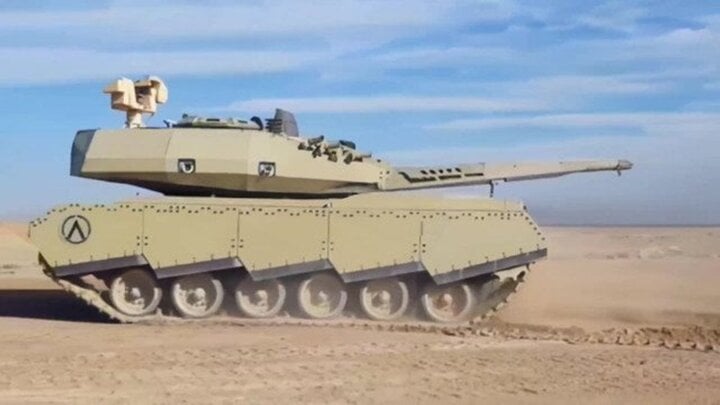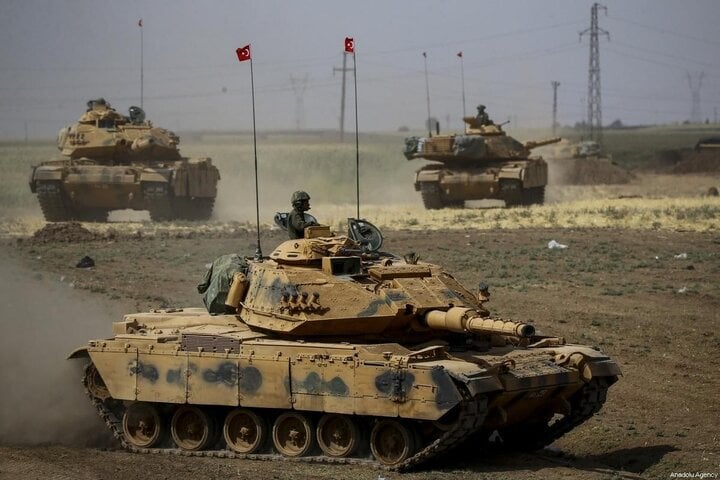On March 15, a video appeared on social networks showing images of an upgraded version of the M60 tank, believed to be a product of Iran’s defense industry. The Islamic Republic of Iran currently has about 150 US-made M60 tanks. This batch of tanks, initially totaling 460 units, is a legacy inherited by the Islamic Republic of Iran Armed Forces (IRIAF) since the 1979 Islamic Revolution.
The Iranian modifications revealed in the video show clear differences, completely different from the original M60s produced by the US during the Cold War. However, because the video length is quite short, the video was initially revealed by Iranian sources, which somewhat limits any comprehensive analysis of the upgrades on this M60 version. In addition, it seems that Iranian engineers were inspired by futuristic war concepts to redesign this tank.

Iran’s upgraded M60 tank.
Noticeable upgrades
The turret on Iran’s M60 tank immediately attracted the attention of analysts. The turret on this tank has undergone significant modifications or may have been completely replaced. Although it is difficult to determine exactly what changes have been made, when compared to the original M60 tank turret, the Iranian version is noticeably different.
Another impression is the modular fairings mounted on both sides of the vehicle’s body. The turret is also equipped with a modern combat module and is mounted with a machine gun similar to that found on modern tanks. In addition, there are additional modifications such as slanted hull and armor on both sides of the vehicle.
Experts have also made many speculations about the main gun on the tank. On the American versions M60/M60A1 and M60A3, only the main gun has a caliber of 105 mm. Only the M60A2 version is equipped with a 152 mm gun, but this model has never been exported to Iran.
Therefore, it is very possible that Iran has replaced the 105 mm gun on the old version with a larger 120 mm gun or even a 125 mm gun, something Iran also did on the Zulfiqar tank. This speculation is further reinforced by the close relationship between Russia and Iran, as well as the popularity of 125 mm guns on the main battle tanks that Iran is staffing.
“Copy” of M60T Sabra
Interestingly, experts have noticed amazing similarities between Iran’s modernized M60, and the M60T Sabra version modernized many years ago and in service with the Israeli armed forces. Even the modifications on Iran’s main gun seem to be affected by the upgrade on the Israeli M60T.
When considering upgrading armored vehicles like the M60T Sabra, experts point to three important areas including firepower capabilities, armor protection resilience and mobility efficiency. Firepower is maximized through the integration of advanced guidance systems, expanding the diameter of the main gun and allowing the adoption of new weapon systems.
In terms of protection, the evolution comes in the form of reactive and synthetic armor, thus providing superior defense against anti-tank weapons. Improvements in handling have been achieved thanks to powerful engines and advanced suspension systems, enhancing maneuverability over a variety of terrains.
In short, the improvements made to the M60T Sabra have ensured its long-term relevance in modern warfare, ensuring its ability to meet evolving challenges on the battlefield. However, the development and birth of the Merkava tank caused the M60T to gradually lose its role. Although the M60T tank has been replaced by the more advanced Merkava, the M60T still represents an important milestone in Israel’s tank development, serving as the basis for the birth of the next generation of tanks. .
Iran was the country that benefited the most from American and British military weapons in the 1970s. During his reign, the last Shah of Iran, Mohammad Reza Pahlavi, had financial resources. abundant thanks to skyrocketing oil prices after the 1973 Arab-Israeli conflict. With this wealth, he bought a number of advanced weapons for the Iranian army at that time.

M60T Sabra tank.
Iranian M60 tank
There are some key differences when comparing the Iranian M60 with the original American version. Most prominent is the upgraded armor and firepower. Specifically, equipping explosive reactive armor on the entire body and turret of the tank. Furthermore, the vehicle is also equipped with a laser rangefinder and thermal imaging system to help improve accuracy when destroying targets.
Technical specifics also attract a lot of attention. Iran’s M60 uses an air-cooled Continental AVDS-1790-2 V12 twin-turbo diesel engine, with a capacity of up to 750 horsepower. On flat roads, this tank reaches a maximum speed of 48 km/h and an operating range of about 500 km. In terms of weight, the tank weighs about 52.6 tons, is about 9.3 meters long, 3.63 meters wide and 3.27 meters high.
Iran’s M60 tanks are also equipped with a number of specially designed systems to improve combat effectiveness. Includes a ballistics computer that increases precision shooting, a laser target finding system to estimate specific distances, and a thermal imaging system that improves target visibility in harsh conditions. In terms of protection, the tank is equipped with a nuclear, biological and chemical (NBC) defense system and a camouflage smoke generator.
The vehicle is equipped with a 105 mm M68 cannon that can launch a variety of projectiles, including high-explosive anti-tank rounds (HEAT) and armor-piercing fin-stabilized rounds (APFSDS). In addition, the M60 also carries an M240 7.62 mm machine gun and a 0.50 caliber M2 Browning machine gun, both of which are designed for anti-aircraft and anti-infantry capabilities.





